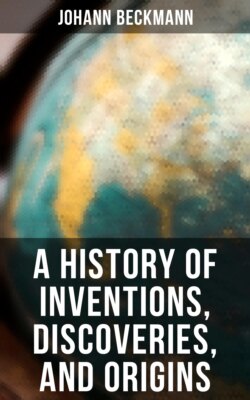Читать книгу A History of Inventions, Discoveries, and Origins - Johann Beckmann - Страница 42
На сайте Литреса книга снята с продажи.
FOOTNOTES
Оглавление344 Gattereri Elem. Artis Diplom. 1765, 4to, p. 285.
345 It is singular that Pliny denies that the Egyptians used seals, lib. xxiii. c. 1. Herodotus however, and others, prove the contrary; and Moses speaks of the seal-rings of the Egyptians. See Goguet.
346 Herodot. lib. ii. c. 38.
347 Lucian. in Pseudomant.
348 Act. iv. ap. Bin. tom. iii. Concil. part. i. p. 356. Whether the γῆ σημαντρὶς, however, of Herodotus and the πηλὸς of Lucian and of the Byzantine be the same kind of earth, can be determined with as little certainty as whether the creta, called by some Roman authors a sealing-earth, be different from both.
349 Orat. in Verrem, iv. c. 9. In the passage referred to, some instead of cretula read cerula. I shall here take occasion to remark also, that in the Acts of the Council of Nice before-mentioned, instead of πηλὸν some read κηρόν: but I do not see a sufficient reason for this alteration, as in the before-quoted passage of Lucian it is expressly said, that people sealed κηρῷ ἣ πηλῷ. Reiske himself, who proposes that amendment, says that πηλὸν may be retained. Stephanus, however, does not give that meaning to this word in his Lexicon. Pollux and Hesychius tell us, that the Athenians called sealing-earth also ῥύπον.
350 Orat. pro Flacco, c. 16.
351 Serv. ad lib. vi. Æneid. p. 1037.
352 Lib. xii. c. 43.
353 Georg. i. v. 179.
354 Creta fossica, qua stercorantur agri.—Varro, i. 7. 8. It appears also that the πηλὸς of the Greeks signified a kind of potters’ earth. Those who do not choose to rely upon our dictionaries, need only to read the ancient Greek writers on husbandry, who speak of ἀῤῥαγεῖ πηλῷ ἀργιλλώδει. See Geopon. x. c. 75. 12, and ix. c. 10. 4.
355 I piombi antichi. Roma 1740, 4to, p. 16.
356 Heineccius and others think that the amphoræ vitreæ diligenter gypsatæ, in Petronius, were sealed; but it is much more probable that they were only daubed over or closed with gypsum, for the same reason that we pitch our casks.
357 [Blue wax may now be seen in every wax-chandler’s shop; it is coloured blue by means of indigo.]
358 Heineccii Syntagma de Vet. Sigillis, 1719, p. 55.
359 Plin. lib. xxii. c. 25.
360 Trotz, Not. in Prim. Scribendi Origine, p. 73, 74.
361 P. Festi de Verb. Sig. lib. xx. Hesychius calls this cement μεμαλάγμενον κηρόν.—Plin. lib. xxxvi. c. 24.
362 Lib. viii. c. 4.
363 Nouveau Traité de Diplomatique. Paris, 1759, 4to, iv. p. 33.
364 Mémoires conc. l’Histoire d’Auxerre. Par. 1743, ii. p. 517.
365 Bibliothèque des Auteurs de Bourgogne, 2 vols. fol. ii. p. 217.
366 Histoire Générale des Drogues. Paris, 1735.
367 This Rousseau appears also in the History of Cochineal, as he sent to Pomet a paper on that subject, which was contradicted by the well-known Plumier in the Journal des Sçavans for 1694. He is mentioned also by Labat, who says he saw him at Rochelle; but at that time he must have been nearly a hundred years of age.
368 Von Murr, in his learned Beschreibung der Merkwürdigkeiten in Nürnberg, Nurnb. 1778, 8vo, p. 702, says that Spanish wax was not invented, or at least not known, before the year 1559. This appears also from a manuscript of the same year, which contains various receipts in the arts and medicine. There are some in it for making the common white sealing-wax green or red.
369 See Chronicon Godvicense, p. 102.
370 Wecker gives directions also to make an impression with calcined gypsum, and a solution of gum or isinglass. Porta knew that this could be done to greater perfection with amalgam of quicksilver; an art employed even at present.
371 Tavernier, in his Travels, says that in Surat lac is melted and formed into sticks like sealing-wax. Compare with this Dapper’s Asia, Nuremberg, 1681, fol. p. 237.
372 Bruchstücke betreffend die Pflichten eines Staatsdieners; aus den Handlungen des Raths Dreitz, nebst Bemerkungen vom ältesten Gebrauche des Spanischen Siegelwachses, Frankf. 1785, 4to, p. 86; where the use of these antiquarian researches is illustrated by examples worthy of notice.
373 Historische Untersuchungen gesammelt von J. G. Meusel, i. 3, p. 240.
374 Original Letters of the Paston Family, temp. Henry VI. i. p. 21, and p. 87 and 92.
375 Meusel’s Geschichtforscher. Halle, 8vo, vi. p. 270.
376 Ibid. iv. p. 251.
377 Aromatum et Simplicium aliquot Historia, Garcia ab Horto auctore. Antverpiæ 1574, 8vo, p. 33.
378 Neu Titularbuch—sambt etlichen hinzugethanen Gehaimnüssen und Künsten, das Lesen und die Schreiberey betreffendt. 4to, 1579, p. 112.
379 Archivische Nebenarbeiten und Nachrichten. Halle, 1785, 4to, ii. p. 3.
